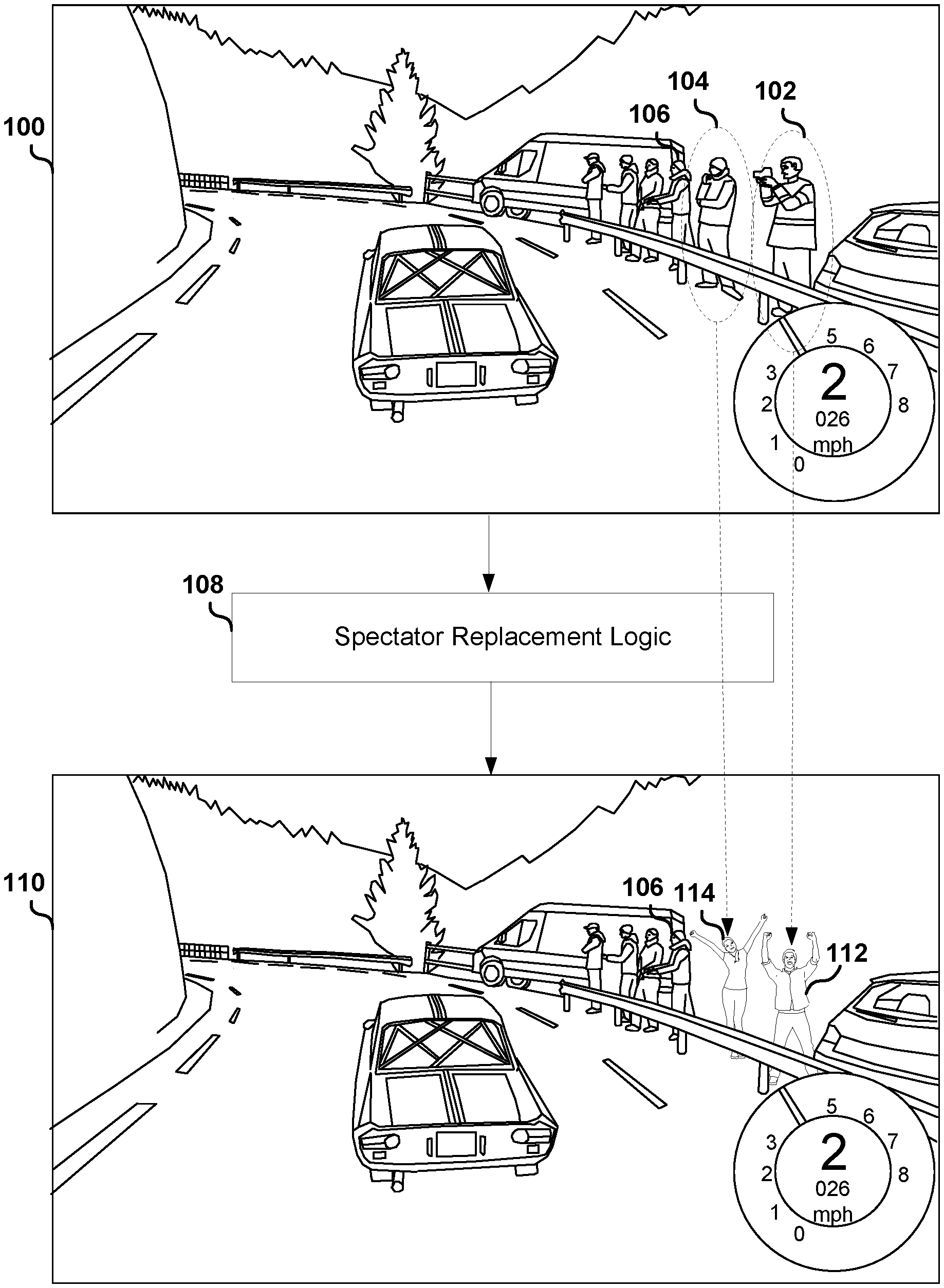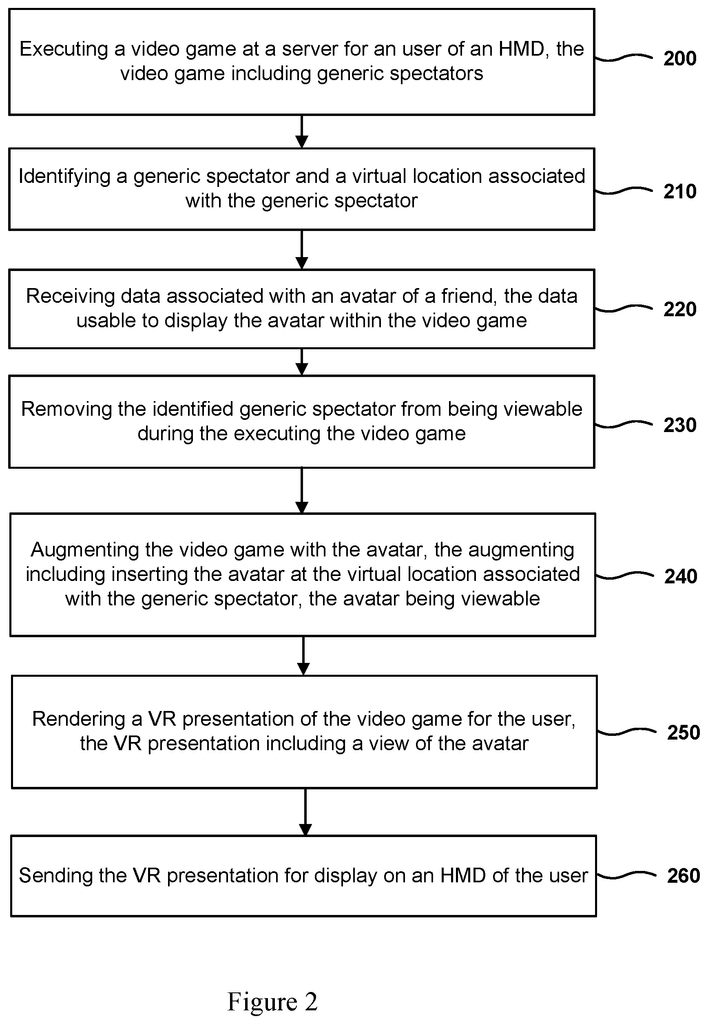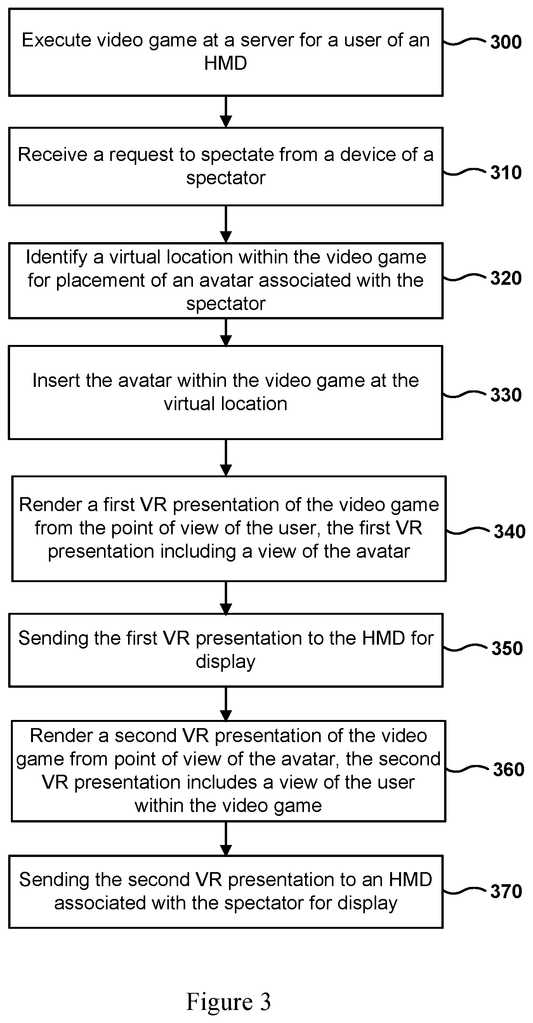Invented by Mohammed Khan, Matt DeVico, Shawn He, Sony Interactive Entertainment LLC
Virtual reality has already revolutionized the gaming industry by providing players with a more immersive and realistic experience. However, the addition of friend avatars takes it a step further, enabling gamers to connect and play with their friends in a virtual environment. This feature not only enhances the social aspect of gaming but also creates a sense of presence and camaraderie among players.
One of the key advantages of augmenting VR video games with friend avatars is the ability to play together regardless of physical distance. With the pandemic restricting physical gatherings, virtual reality offers an alternative way for friends to connect and enjoy gaming experiences together. Whether they are in different cities or even countries, players can join forces in a virtual world and collaborate on missions, compete against each other, or simply explore the game’s environment.
Furthermore, friend avatars allow gamers to personalize their virtual experiences. Players can create avatars that resemble themselves or design unique characters that reflect their personalities. This customization not only adds a personal touch to the game but also enhances the sense of identity and ownership over the virtual world. It becomes an extension of the player’s real-life persona, making the gaming experience more meaningful and engaging.
The market for augmenting virtual reality video games with friend avatars is also attracting the attention of game developers and investors. As the demand for VR gaming continues to grow, developers are investing in technologies that enable seamless integration of friend avatars into virtual worlds. Companies are developing platforms and tools that allow players to create and customize their avatars, as well as interact with their friends’ avatars in real-time.
Moreover, the potential for monetization in this market is significant. Players are willing to spend money on virtual goods and accessories to enhance their avatars’ appearance and abilities. This creates opportunities for developers to offer a wide range of customization options and in-game purchases, generating revenue and sustaining the growth of the market.
However, there are challenges that need to be addressed for the market to reach its full potential. One of the main concerns is ensuring the privacy and security of players’ personal information. As friend avatars require players to share data and connect with others, it is crucial to establish robust privacy measures to protect users’ identities and prevent any misuse of their information.
Additionally, developers need to focus on creating seamless and intuitive user experiences. The technology behind friend avatars should be user-friendly and accessible to a wide range of gamers, regardless of their technical expertise. This will ensure that the market reaches a broader audience and maximizes its potential for growth.
In conclusion, the market for augmenting virtual reality video games with friend avatars is an exciting and rapidly expanding sector within the gaming industry. It offers players a more immersive and social gaming experience, allowing them to connect and play with their friends in virtual worlds. With advancements in technology and the increasing demand for VR gaming, this market holds immense potential for growth and innovation. As developers continue to invest in this space, we can expect to see more exciting developments that further enhance the gaming experience and bring friends closer together in virtual reality.
The Sony Interactive Entertainment LLC invention works as follows
Systems and methods are provided for augmenting video games with an avatar that represents a real-world person. A method is provided for executing the video game played by an individual via a HMD. The method comprises operations for identifying generic spectators within the video game, and determining virtual co-ordinates associated with them. The method includes receiving data that can be used to display an avatar in the form of three-dimensional (3D). The method includes removing the generic viewer from the video and inserting an avatar at virtual coordinates that are associated with the spectator. The method also renders a virtual-reality (VR) presentation for the user who has a view of an avatar, and sends the VR presentation to a HMD for display.
Background for Augmenting Virtual Reality Video Games with Friend Avatars
Many video games include generic or “fake” spectators. spectators. Generic spectators make video game scenes realistic when they are associated with real-world contexts where spectators might be expected. As video games have become more lifelike and realistic, the generic spectators in video games have not kept up. Generic spectators can detract realistic and lifelike video game content.
In this context, embodiments are born.
Embodiments” of the present disclosure are methods and systems for augmenting video games with an avatar that represents a real-world person. In one embodiment of a method, an operation is included for executing the game on a server. The video game is being played by the user via a HMD. The method includes also operations for identifying generic spectators within the videogame and for determining the virtual coordinates of the generic spectator. The method includes an operation to receive, at the server data associated with the virtual spectator, the data that can be used to display the avatar in the video game. The method also provides operations to remove the generic spectator in the videogame and insert the avatar of a real-world person into the game using the data associated the avatar. Inserting the avatar makes the avatar viewable in the video game as a three-dimensional (3D). The method also includes rendering a virtual reality presentation of the game for the user, and sending that VR presentation to their HMD for display. The VR presentation may include a view or the avatar in this embodiment and others.
In another embodiment, there is a data center or server system that has one or multiple server systems. The server system includes one or several processors as well as a memory in communication with each processor. The memory contains processor-executable instruction to play a videogame via an HMD. The memory also stores instructions for identifying a generic observer within the videogame and determining virtual coordinates associated to the generic observer. The memory also includes instructions for receiving data that can be used to display an avatar of a person in real life within the videogame and to remove the generic viewer from the videogame. The memory also includes instructions for inserting the avatar in the videogame at the virtual coordinates of the generic spectator, using the data associated to the avatar. This will allow the avatar to appear within the game as a 3D image. In some embodiments the data associated with an avatar may include 3D vertex information that can be used to render and draw the avatar. The memory also includes instructions for rendering a virtual reality presentation (VR) of the videogame for the user, which includes a view in 3D of the avatar and for sending the VR presentation to HMD for display.
In a further embodiment, an executable computer program is stored on a non-transitory media. The computer program contains instructions for executing a videogame that can be played by an individual via an HMD. The provided computer program also includes instructions for identifying a generic observer within the game, determining virtual coordinates that are associated with the spectator and receiving data from the avatar of a real-world person to display the avatar in the game. The computer program includes instructions for removing the generic spectator in the video and inserting the avatar at the virtual coordinates of the generic observer using the data that is associated with the avatar. This will allow the avatar to appear in 3D within the game. The computer program also includes instructions for rendering a VR version of the video game that includes a 3D view of the avatar and sending the VR version to the HMD for display.
The following detailed description taken together with the accompanying illustrations, which illustrate the principles of disclosure by way of an example, will reveal other aspects of the disclosure.
The following embodiments describe computer programs and apparatuses that augment video games with avatars or friends, in addition to generic, “fake” existing avatars. spectators. To a person skilled in the arts, it will be evident that this disclosure can be performed without all or some of these details. Other times, well-known process operations are not described in great detail to avoid unnecessarily obscuring the disclosure.
Many video games display fake images to enhance the realness and playability of the game. The game is more realistic and enjoyable when there are spectators. It is more appealing and natural for some players to play basketball in an auditorium with spectators rather than an auditorium with empty seats. It is the same for racing games, sports teams, combat sports and other video game categories. The gaming experience is enhanced by the use of generic or “fake” spectators. In situations where there would be real-world spectators.
However as video games have become more realistic and lifelike, generic observers have not kept up. The presence of generic spectators can detract from what would otherwise be an incredibly realistic and lifelike video game scene. Current generic spectators, for example, are rendered nondescriptively and unrecognizable. The generic spectators in the current video games do not represent real-life friends or family members that the player might want to see while playing the game. It is more appealing and effective to have friends cheer you on than to have a ‘fake’ spectator cheering you on. spectators. There is an opportunity to enhance the gaming experience with friends avatars instead of fake spectators or in addition. Being able to watch your friends react or cheer you on makes for a much more engaging and entertaining gaming experience.
There is also the option to show spectator views to a friend who has inserted their avatar into a videogame. These spectator views can be displayed either in real time as the player navigates through the video game or they can be saved for later viewing. The methods and system described here can provide a social layer that will allow for greater engagement and entertainment of both the player and their friends.
As used here, “generic observers” is taken to mean?fake? “As used herein,?generic spectators? “Scientists, nonplayer characters, characters that are not real people, or characters of any kind.
FIG. The figure 1 shows a conceptual representation of an embodiment that augments a VR video game by adding friend avatars. This is done using spectator replacement logic. In a first VR scene of the VR game, there are shown a racing game with a number generic spectators. These include a first generic viewer 102, a secondary generic observer 104, as well as a third generic observer 106. In the second VR scenario 110 of the VR game, it is shown that the spectator replacement logic has replaced the first generic avatar with first friend 112 and second friend 114. The third generic avatar is shown to be unchanged.
In some embodiments the friend avatars are real-time images of friends who are watching a VR game while a player is playing it. In some embodiments, friend avatars may be pre-programmed videos of friends that are associated with the avatars. These clips can then be rendered when the VR game is executed. FIG. In the embodiment of FIG. The friend avatars 112 & 114 are a life-like representation of the friends associated. In some embodiments, the friend avatars do not have to resemble their associated friends, but can take any form that the associated friend chooses. The associated friend can choose their favorite character or create their own avatar. The VR game becomes more engaging, personable and realistic by adding the avatars of friends 112 and114. The addition of avatars to video games, such as those of friends or family members, is a way to improve video game technology.
In certain video game embodiments, the player’s movement in a virtual terrascape or virtual world or scene can be so fast that it is difficult to identify or resolve spectators who are still. In racing games, for example, players can reach speeds so high that it is difficult to distinguish or identify individual spectators. As a player speeds past the spectators, the friend avatars 112 and 114 may only appear to the player for a period of about 0.1 seconds to approximately 2 seconds. According to the embodiment, the friend avatars may appear for only a short time, such as 0.1 to 2 seconds. This may not be enough for the racing game player to recognize them.
In certain embodiments, the speed of presentation for the video game can be reduced when the avatar is visible to the user. When the avatar has been removed from the view of the user, the speed of presentation can be increased. In other embodiments the avatars’ size may be increased to allow the user a better view, in conjunction with slowing/speeding up of the presentation speed of the video game.
FIG. According to one embodiment, FIG. 2 illustrates the overall flow of a technique for augmenting a VR game with a friend’s avatar. Operation 200 executes at a server a videogame for an HMD user, including generic spectators. The method identifies at operation 210 a generic observer and a virtual place associated with that generic spectator. The method proceeds to operation 220 which receives data related to the friend avatar. This data is used to display the avatar in the video game.
In operation 230, this method prevents the generic spectator identified from being viewed during the execution of the video game. Operation 240 augments the video game by inserting the friend avatar.
The method proceeds to operations 250 and 265, which render a VR-presentation of the videogame for the user. This VR-presentation includes a view the avatar and sends the VR-presentation to be displayed on the HMD.
In some embodiments, the operation 210 can identify the generic spectator at random. In some embodiments, operation 220 may identify the spectator based on how visible or prominent they are within the videogame. According to these embodiments of operation 210, generic spectators who appear prominently in the video game may be identified so that the friend avatar can also appear prominently for the player.
Furthermore,” according to certain embodiments, the operations 210-240 can be repeated so that a plurality generic spectators are identified and replaced by the same friend avatar. In these embodiments the player is given multiple chances to see the friend avatar while playing the video game.
Click here to view the patent on Google Patents.




